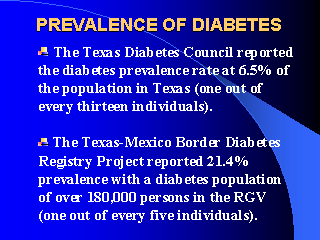|
|
|
|
front |1 |2 |3 |4 |5 |6 |7 |8 |9 |10 |11 |12 |13 |14 |15 |16 |17 |18 |19 |20 |21 |22 |23 |24 |25 |26 |27 |28 |29 |30 |31 |32 |33 |34 |review |
 |
Type 2 diabetes may account for about 90% to 95% of all diagnosed cases of
diabetes. Risk factors for Type 2 diabetes include older age, obesity, family
history of diabetes, prior history of gestational diabetes, impaired glucose
tolerance, physical inactivity, and race/ethnicity. African Americans,
Hispanic/Mexican Americans, American Indians, and some Asian Americans and
Pacific Islanders are at particularly high risk for Type 2 diabetes.
The Texas-Mexico Border Diabetes Registry Project's target population, in the four counties of the Rio Grande Valley (RGV) of Texas, numbered 850,399 persons (1996). Fifty-six percent of the population was from Hidalgo County, 35.5 % from Cameron County, 6.3% from Starr County and 2.2% from Willacy County. Fifty-eight percent of the Diabetes Registry database population is from Hidalgo County, 31% from Cameron County, 6% from Starr County and 5% from Willacy County. The majority of the population are females (64%). The sex distribution of persons with diabetes presented a two-to-one ratio (female to male) that was consistent in all four counties. This would suggest a higher risk of diabetes among females through out the Rio Grande Valley of Southern Texas. Stronger associations are evident with the increase of disparity between female and male among the age groups reported. As age increased, so does the number of individuals with diabetes, but the increase is greater among the female population. The largest difference between females and males was noted among the 60-64 and 65-69 age groups with the smallest difference noted among ages 5-19 years. The average age of the Diabetes Registry population was 57 years for males and 56 for females. Dental public health education and prevention programs to promote a satisfactory level of personal control of diabetes mellitus and personal oral hygiene should be directed at populations most susceptible to Type 2 DM, of which the most consistently identified are the Mexican-American population of Texas, particularly the people of the Lower Rio Grande Valley. |